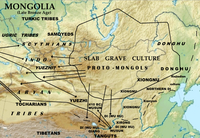
Photo from wikipedia
Abstract Plant remains from graves shed light on the usage of plants as part of the burial customs, economy or diet of the past. The aim of this interdisciplinary study… Click to show full abstract
Abstract Plant remains from graves shed light on the usage of plants as part of the burial customs, economy or diet of the past. The aim of this interdisciplinary study was to examine what new information can be acquired from graves by combining archaeobotanical and pollen data with archaeological results. The study material consisted of soil samples from 158 graves of nine different archaeological sites in southern Finland, dated from the Iron Age to the 16th century. Archaeobotanical results from the graves were generally rather modest. However, remarkable results were gained from a 16th century grave at the Kappelinmaki cemetery in Kauskila, Lappeenranta. The grave gave evidence of the deceased's last meal, since a large number of raspberry seeds and some fish bones were discovered. Pollen analysis of the same grave gave evidence of funeral practices and ritual usage of plants. Due to local soil conditions, plant material was generally not preserved in the inhumation graves. Preserved plant material can be associated with the graves with well-preserved human bones and / or the graves containing plentiful metal artefacts.
Journal Title: Journal of Archaeological Science: Reports
Year Published: 2017
Link to full text (if available)
Share on Social Media: Sign Up to like & get
recommendations!